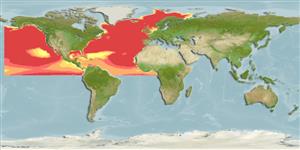Teleostei (teleosts) >
Lophiiformes (Anglerfishes) >
Thaumatichthyidae (Wolftrap anglers (Ref. 7463), Wolftrap Seadevils (Ref. 86949))
Etymology: Lasiognathus: Greek, 'lasios' = hairy or wooly + Greek, 'gnathos' = jaw (with reference to the huge number of long teeth of the upper jaw) ( Ref. 86949).
Eponymy: Dr Charles William Beebe (1877–1962) was an American naturalist, ornithologist, marine biologist, entomologist, explorer and author. [...] (Ref. 128868), visit book page.
More on authors: Regan & Trewavas.
Environment: milieu / climate zone / depth range / distribution range
Ecology
Marine; bathypelagic; depth range 0 - 1100 m (Ref. 27827). Deep-water
Eastern Central Pacific: Hawaii. Atlantic Ocean: Madeira and Bermuda.
Size / Weight / Age
Maturity: Lm ? range ? - ? cm
Max length : 11.5 cm TL (female)
Dorsal soft rays (total): 6 - 7; Anal soft rays: 4 - 5. Escal bulb without membranous anterior crest. Distal escal appendage compressed, transversely fan-shaped, bearing three bony escal hooks along posterior margin, without elongate prolongation emerging from bases of escal hooks. Posterior escal appendage cylindrical, tapering to a point (Ref 27827). Length of illicium 43-44%SL in small specimens, 47-50%SL in large specimens (8 to 11.2 cm); posterior escal appendage 0.5-2.5%SL, emerging from below escal pore; thin edge of distal appendage behind and between bases of escal hooks more or less folded; length of distal appendage, measured from surface of escal bulb to bases of escal hooks, 1.3-2.8% SL (Ref. 86949).
A piscivore, feeding occasionally on invertebrates (Ref. 27828).
Life cycle and mating behavior
Maturity | Reproduction | Spawning | Eggs | Fecundity | Larvae
Bertelsen, E. and T.W. Pietsch, 1996. Revision of the ceratioid anglerfish genus Lasiognathus (Lophiiformes: Thaumatichthyidae), with the description of a new species. Copeia 1996(2):401-409. (Ref. 27827)
IUCN Red List Status (Ref. 130435: Version 2024-1)
Threat to humans
Harmless
Human uses
Tools
Special reports
Download XML
Internet sources
Estimates based on models
Preferred temperature (Ref.
123201): 0.8 - 14.9, mean 4.9 °C (based on 1126 cells).
Phylogenetic diversity index (Ref.
82804): PD
50 = 0.5352 [Uniqueness, from 0.5 = low to 2.0 = high].
Bayesian length-weight: a=0.01995 (0.00906 - 0.04395), b=3.01 (2.83 - 3.19), in cm total length, based on all LWR estimates for this body shape (Ref.
93245).
Trophic level (Ref.
69278): 4.0 ±0.63 se; based on food items.
Fishing Vulnerability (Ref.
59153): Low vulnerability (10 of 100).
